Back by popular demand, the Rio Pecos Kennel Club presented its third annual pet fair to the public at Cahoon Park in mid-April. Unlike their annual sanctioned Dog Show and Obedience Trial Show that showcases AKC purebred show dogs, this fair welcomes all types of dogs, including mixed breeds and family pets, and a few other types as well.
Elaine Mayfield, current Rio Pecos Kennel Club president as well as zoo director of Spring River Park and Zoo, was the able show-master.
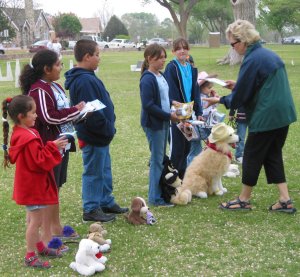
The fair opened with young handlers showing off their various breeds of stuffed animals.
Next came another fun part of the fair, the Best Pet Costume contest.
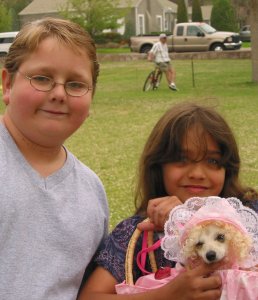
Bunny (so-named “because she hops like a bunny”) competed in the costume contest looking like Goldilocks, shown here with her handlers, Tristan and Lauren Dunbarr.
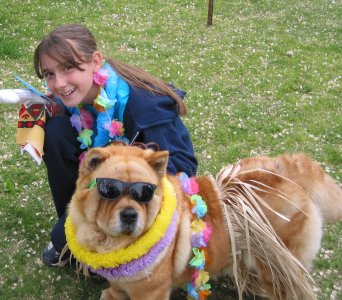
These next two are not in costume; they are the real deal. New Mexico State Police K-9 Officer Patrick Gonzales and another officer of the law, Lady, narcotics-sniffing German Shepherd, were available for interviews.
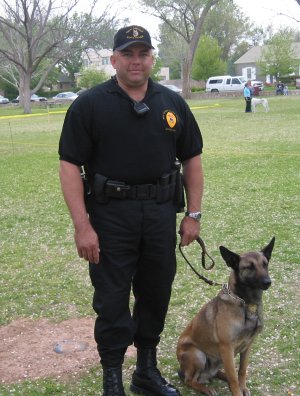
Various breeds, some unusual, were introduced to the audience, with brief histories and characteristics given on each one.
Pictured below are Salukis, an unusual breed of dog originating in Persia, believed to be the oldest purebred dog in existence; their breed has been traced back 7,000 years. They are known as “sight hounds” because, unlike most types of hounds that rely upon keen sense of smell, these dogs visually seek their quarry.

Two young Salukis

High-energy dogs, sometimes accompanied by their handlers and sometimes strutting their stuff on their own, flew through various trials showcasing their skills, agilities, abilities and obedience. These included relay and rally courses with hurdles, flying disk throws and fly-ball with teams of two or four dogs competing together across a course with hurdles to leap, a spring-loaded box to hit which throws out tennis balls that each catches and runs with back through the course.
Paris, a chocolate toy poodle, was one of the high-energy hurdle-jumping dogs competing with others in relay and fly-ball courses. He, and a group of other Duke City Chile Dogs of various pure breeds, came to Roswell from Albuquerque to compete in the events.

Many of the event competitors were amazingly focused Border Collies. Focused, that is, on the objects of their events. Amie, however, was — for hours — also particularly focused on another dog. The object of her unblinking stare and apparent adoration was a Duke City Chile dog, another Border Collie that looked exactly like her but apparently was unrelated and unacquainted.

Marge Woods, head zookeeper at Spring River Park and Zoo, and her assistant presented a few pets and zoo-residents. Those included a turtle, a parrot and a coatimundi. A coati is a mammal from the tropics of Central or South America. Kin to the raccoon, it has a longer body and tail, and a long flexible snout. Shippen Davis, a volunteer at the zoo, adopted and raised this coati from babyhood.

Elaine Mayfield and other Rio Pecos Kennel Club members guesstimated that 75 dogs participated at this year’s pet fair.
Are you aware Chaves County has an Animal Welfare Alliance? “Roswell area residents working together to promote no-kill solutions for homeless and abandoned cats and dogs” is their purpose.
It is a non-profit association of people who love animals and work to improve the lives of all homeless or abused pets. Their primary goal is two-fold: a.) to reduce the number of canine and feline births by spaying and neutering homeless cats and dogs, and b.) to reduce the numbers of those that Animal Control must euthanize due to limited space and money. Animal Control keeps animals for only seven days before they are put down. Thousands are painfully destroyed each year in Roswell alone.
AWA has cages to humanely trap feral cats so they can be taken to veterinarians “to be fixed” and then released. These cages can be borrowed for this purpose. The group desperately needs funding and also willing assistants for this huge undertaking. They also seek homes for animals before they are destroyed by Animal Control. In addition to arranging permanent adoptions to good homes (for as little as $1), AWA seeks foster homes where animals can safely stay until they are adopted.
Animal Welfare Alliance actively, desperately seeks good and loving — permanent or temporary — homes for pets, donations of money, donations of personal service and time as well as items for raffles and garage sales to benefit the worthy cause of saving animals’ lives. If you can help, call 623-1805. AWA’s next general meeting is 7 p.m. May 4, room 22 at the Roswell Adult Center.
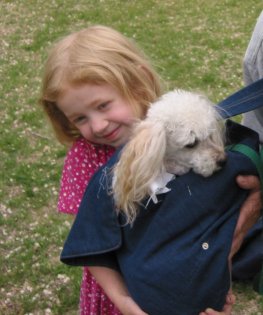
Tipper — a valuable registered poodle of show-dog quality — was brought to us because his owners were keeping him locked in a small, smelly bathroom all day. He was very unhappy and his owners realized that was no life for a dog, so their friend brought him to us. I came home one day to find my husband, Dan, walking the floor with a small apprehensive white critter clinging to his neck, peering out from under long curls. (It was Tipper, not Dan, who needed a haircut.)

Then came HoJo, our five-pound bundle of joy. My grandson and I saw a small animal running inside the ditch at Cahoon Park. Watching, we saw that he was alone. His condition — filthy, long hair, dried mud, tumbleweeds and loaded with parasites — indicated he had been lost or homeless a long time. As we chased after him, sometimes he darted into the busy street, Union, and I dashed out pleading by sign language for motorists to not hit him. Terrified, he ran up the street and into a fenced back yard where a large black dog resided. I knocked on the front door for permission to go into the yard to get the stray. The resident retrieved the little dog — holding it at arm’s length — handing it to us over the fence. She said her dog had adopted the mutt, sharing his food, water and body-warmth, but she hated it and kept chasing it away. We were happy to take it home to clean up and nurture. It took days before the sweet and very grateful toy poodle emerged from the mess.

Then there was Marie de Mici. We were told of a young white poodle at the Humane Society that, unless a special home was found for her, would be put to sleep because she was deaf. My grandson, Brandon, and I went to see her. She has some poodle traits but not entirely. I had never seen an animal that seemed to have such a broken spirit, shoulders hunched, head hanging down, looking so dejected. I went into her cage and reached down and touched her and — startled — she leapt straight up into the air, then wrapped herself around me, clinging tight. She gave me a total bear-hug, a full-body press, and would not let go. Nothing to do but take her home, after we posted her bail. I expected her to be very needy, but immediately upon getting her home and introducing her to our other dogs, she yipped and hollered and delightedly ran around in circles with them. From that moment on, she was never needy or handicapped. After all, she had two hearing-ear dogs and is only seconds behind them in response time. I could write a book about Marie de Mici, her unique and fun personality and the pleasure she gives us.
Along came La Viejita, the Old Woman. I was driving down College approaching the busy intersection of Union when I noticed an odd animal, low to the ground, aimlessly walking down the middle of the street. I pulled my car over, yelled, called, but the animal plodded on. It walked under a car that briefly idled at a stop sign, and plopped itself down in front of one of its tires. Another passerby saw, stopped and tried to help me. We managed to get the dog — for it was a dog — out from under the car before it was run over. Long brown hair, barrel-shaped body, very short legs, upstanding ears, she was unlike any dog I’d ever before seen. Later, a book of dog breeds identified her as a silky terrier. She might have once laid down in soft tar because all of the long hair of her underside was glued to her skin by plates of hardened tar. She was a terrible mess. Her entire body and inside her ears were covered with parasites, many grape-sized. It took days of cleaning, clipping, dipping, and medicating ouchies before she was allowed to even be in the same yard (much less the house) with our other pets. Eventually she passed quarantine, and took up residence inside with the rest of us. She was deaf, blinded by cataracts, and nearly toothless. She lived with us in comfort for two or three years before we finally took her to our vet to put her to sleep.
Over the years, I have rescued many dogs that, happily, wore tags and I was able to reunite them with their concerned families. Many more times, however, I spent hours and even days trying to rescue lost or homeless dogs without success, and thoughts of those poor sad souls wandering alone out there, frightened and helpless, haunted me.
Be humane; have your dogs and cats spayed and neutered. There are many worthy and loveable animals already born desperately needing to be adopted if you want a pet. Call or join the Animal Welfare Alliance if you are an animal lover. They — the Alliance and the animals they save — need all the help they can get.
Lieutenant Col. N.A.M. Dudley Court of Inquiry, Fort Stanton, New Mexico, 1879
Lincoln County War Series Vol. 1 & 2
Editing and Typescript by R. M. Barron, El Paso, Texas
Around noon on July 19, 1878, Lt. Col. Nathan Augustus Monroe Dudley rode into the besieged town of Lincoln, New Mexico accompanied by four of his officers and 35 soldiers made up of cavalry and infantry, 2000 rounds of ammunition, a Gattling gun and a 12-pound brass howitzer. More than just a show of force, they brought enough provisions for a three day stay and Dudley brought with him enough attitude to overflow the Rio Bonito. On the premise of “protecting the women and children” and professing “not to know the houses that the McSween party occupy,” Col. Dudley sets up camp east of town and orders the howitzer pointed directly at the door of the Montano Store across the road which just happens to be crawling with McSween men. These mid-day events are soon followed by one violation after another of the Posse Comitatus Act that prohibited the use of soldiers in any civil action unless personally sanctioned by the President of the United States.
But Col. Dudley was guilty of so much more.
On May 9, 1879 a court of inquiry was convened at Fort Stanton, New Mexico to examine seven charges against Lt. Col. Dudley and determine whether he should face a court martial.
Among those charges are “giving aid to an armed band of outlaws”….”Threatening a Justice of the Peace into issuing warrants of arrest”.… “ plundering the Tunstall store”….”procuring base and wicked men to make false and slanderous statements against the virtue of Susan McSween”……”made false and malicious accusations in an open letter to a newspaper in order to subvert the ends of justice and prevent the Governor from restoring peace”….
The proceedings lasted eight weeks and over 100 witnesses testified. Among those was Governor Lew Wallace, Sheriff George Peppin, Mrs. Susan McSween, Col. Edward Hatch, and of course the Lincoln County War’s most infamous participant, Wm. H. Bonney, “Billy the Kid.” When Billy was asked …
Q: The court asks, were the soldiers, which you say fired at you as you escaped from the McSween house, white or colored troops?
A: White.
Q: Was it light enough for you to see distinctly the soldiers when they fired?
A: Yes, sir by the light of the fire—the house was burning. That made it as light as day for a short distance all around.
The most potentially damaging testimony against Dudley’s actions on July 19, 1878 came from Pvt. James Bush when he revealed that Col. Dudley, fearing that McSween men would attempt an escape from the McSween home during the heavy gunfire, twice ordered his soldiers to fall into line and prevent the escape of the inmates from the burning house.
But despite the efforts of the prosecution led by Capt. H.H. Humphreys, Recorder, and assisted by Las Vegas, New Mexico attorney Ira E. Leonard, Col. Dudley and his attorney, Henry Waldo, were successful in convincing a jury of Dudley’s innocence. In fact, the jury took only two minutes to reach a verdict.
After reading the documents contained in the Dudley Court of Inquiry, the reader may well reach a different conclusion, as it seems the inquiry was held more for the vindication of the army than in finding fault with Dudley or his troops.
Robert M. Barron’s Lieutenant Col. N.A.M. Dudley Court of Inquiry is an hour-by-hour dramatization of the events during the five days of war in Lincoln. Mr. Barron spent five years deciphering and transcribing over 1,800 pages of handwritten testimony from several different court reporters. Also included in this two-volume set are documents and military communications never before published that were deliberately omitted from the files of the inquiry. To no one’s surprise, they strongly suggest a white-wash of Col. Dudley’s actions. But it is in the testimony of the individual witnesses that brings another aspect to this book. It offers a rare opportunity to observe the colorful life and times of the late 1800’s in a place still experiencing the “Wild West” and struggling to stay civilized. The comments against individual citizens alone is stuff of which no courtroom today would allow an attorney to express, calling a Justice of the Peace “ a stupid, ignorant old man,” or accusing an adversary of “looming up above the waste water of the Dead Sea of selfishness,” and calling one of McSween’s servants “a dull heavy beast…” There was no love lost between Susan McSween and Col. Dudley as is evidenced by the many affidavits, procured by Col. Dudley against Mrs. McSween’s reputation and virtue, which are contained in this document.
Bob Barron originally self-published this document as a large four-volume set. I have spent the last two years investigating continued interest in the subject as well as redesigning, without omitting any material, the entire document and updating historical photos. The result is a smaller two-volume set that is now available for limited distribution through http://www.bookhousefulfillment.com/ No Lincoln County War and Billy the Kid aficionado wants to be without this two-volume book. As his daughter and the editor of this 2nd edition, I extend my heartfelt gratitude to individuals and groups such as the Billy the Kid Outlaw Gang, historians Fred Nolan and Leon Metz, and many others for their help and support in making this re-distribution a reality. There are so many of us out there who are always craving ever more nuggets about this exciting event in history and I hope this book helps satisfy your appetite.
November 2003
LIEUTENANT COLONEL N.A.M. DUDLEY, COURT OF INQUIRY,
FORT STANTON, NEW MEXICO 1879
Introduction by Leon Metz, Editing and Transcript by R. M. Barron
Lieutenant Colonel N.A.M. Dudley Court of Inquiry,Fort Stanton, New Mexico 1878 was originally released in January 1996. The creator of this document, Robert M. Barron of El Paso, Texas, labored for five years to transcribe, from microfilm, the entire proceedings of the Dudley Court of Inquiry. He then painstakingly indexed those volumes, creating a work that all Lincoln County War enthusiasts, western history buffs, and Billy the Kid aficionados alike would do well to have in their collections. The following is a review of the book that appeared in the January 1996 issue of True West Magazine …
“ All western buffs have some knowledge of Lincoln’s Five Day Battle of 1878 in which lawyer Alexander McSween and several of his followers were killed and Billy the Kid made a daring escape from the burning McSween home. Colonel N.A.M. Dudley was there with troops and could have made a difference in the battle’s outcome. By avoiding direct action, he allowed the forces of Sheriff Peppin to win.
Dudley’s controversial actions during the Lincoln County War included using United States troops in violation of the posse comitatus act. Governor Lew Wallace called for Dudley’s recall, and a court of inquiry followed to determine if enough evidence of wrongdoing existed to convene a court martial.
From May 2 through July 2, 1878, the court of inquiry heard testimony on seven specific charges against Dudley, including giving aid to an armed band of outlaws, plundering the store of John Tunstall, and making slanderous charges against the virtue of Mrs. McSween. The testimony was tediously recorded in longhand and preserved.
Although recorded in microfilm and available at the National Archives, the transcript proved difficult to use because it lacked an index. Researchers had to go to Washington, DC, and painstakingly peruse the entire file to take advantage of its content. Now Bob Barron has transcribed the entire testimony exactly as it was recorded during the court of inquiry. The result is available in four combined volumes totaling 984 pages and completely indexed.”
Mr. Barron self-published and distributed this work, and only a few copies were sold before his death in March of 1997. Bob Barron was my father and I have taken on the task of making this work once again available for purchase. However, some changes have been made from the original form in which the book was distributed. Originally the document was 8 ½ x11, spiral bound and printed on only one side of the sheet which resulted in a very large four-volume set. It also included some illustrations of notables such as Col. Dudley, Billy the Kid, Alexander McSween, and several others. These pictures were of somewhat poor quality. The new 2nd printing will bring the set to two volumes, in a 6 x 9 size, will include more photos, and be perfect-bound. The entire original has been digitally scanned for pure quality and completes at just under 1,000 pages.
The mail order price is $90.00 plus S&H and is available through an on-line book ware-house distributor. The new format of the book was created by BeaverPond Press of Edina, Minnesota (http://www.beaverpondpress.com/) and is available now through the book distributor at http://www.bookhousefulfillment.com/. Reseller’s prices are reduced 40%. You can also obtain books directly from me at d.tatting@worldnet.att.net Please feel free to call me with any questions at 651-464-0175.
Included in the book is an Introduction by author Leon Metz of El Paso, Texas. He does an excellent job of summarizing the Lincoln County War and the events that led to the court of inquiry. He mentions there that “The testimony of Billy the Kid is probably the best known and most widely quoted of the entire file” and “It is a Who’s Who of the Lincoln County War.” The back cover also includes a recommendation from historian Fred Nolan.
Thank you for your time and please don’t hesitate to contact me or BeaverPond Press with any questions or concerns.
Donna Tatting
The opinions of the current members of the Billy the Kid Outlaw Gang about the proposed exhumation are divided. Most of the Gang, many of whom are serious historians who’ve spent years of their lives studying the various documented histories of Bonney’s life, and its board of directors, believe in “the traditional” version of Billy’s death in Ft. Sumner in 1881. But about the exhumation of Billy and his mama, they are divided into three groups. One welcomes the exhumations for further investigation of the truth about Billy. Another portion of the gang is very opposed to the exhumations, believing New Mexico has common sense and history on its side and there would be nothing gained by doing it. The third group is ambivalent with no preset opinion about the exhumations, one way or the other.
The Billy The Kid Outlaw Gang advocates and practices an open forum. It is open to all opinions, provided those are inoffensively stated — whether verbal or in writing — in a polite, well-mannered fashion. The modern-day BTKOG members are ladies and gentlemen who, despite their personal opinions about the exhumation controversy and other issues, encourage differences of opinion about Bonney, Garrett and other historical characters of this area and that time, provided they are politely expressed.
BTKOG
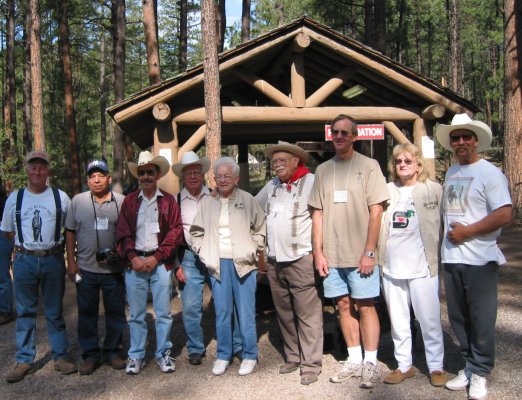
Pictured are some Billy the Kid Outlaw Gang officers for 2003-2004 who gathered with other members in July 2003 at their annual BTKOG campout near Ruidoso. Pictured (left to right above) are: Ronald Hadley, Gene Litka, Bob Logue, Wes “Doc” Owen, Peg and Bob “Doc” Sproull, Paul Blevins, Carol and Joe Hesseling.
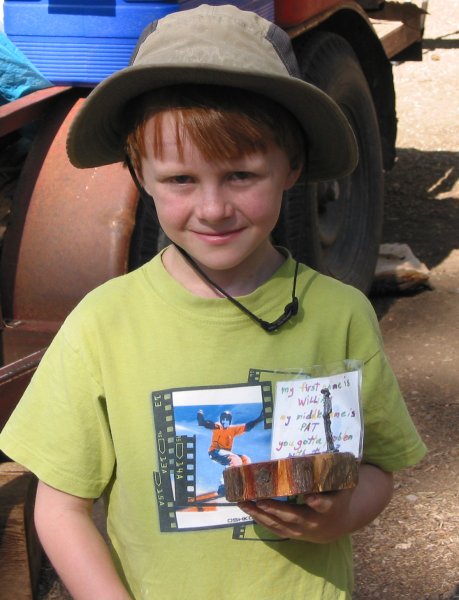
The origins and genealogy of Billy “The Kid” Bonney and his early life remain a mystery. So too is the mystery of why he, in the latter portion of his short life, adopted the name Bonney. Most published historians think that: a.) He began life in New York as Henry McCarty; b.) He changed his name to William Henry Antrim to match his stepfather’s after his mother’s marriage in Santa Fe in 1873; and c.) He adopted the name William H. or Billy Bonney in the last years of his life. Historians don’t know from where he acquired or why he adopted the Bonney name. Serious historians admit that they are uncertain of his origins, but think he might have been born in a New York City Irish slum in 1859. Both the place and the date of his birth could be incorrect.
Billy’s entire life is shrouded in mystery and controversy. Even his demise has been questioned and an official investigation is now underway.
 Roswell Web Magazine
Roswell Web Magazine